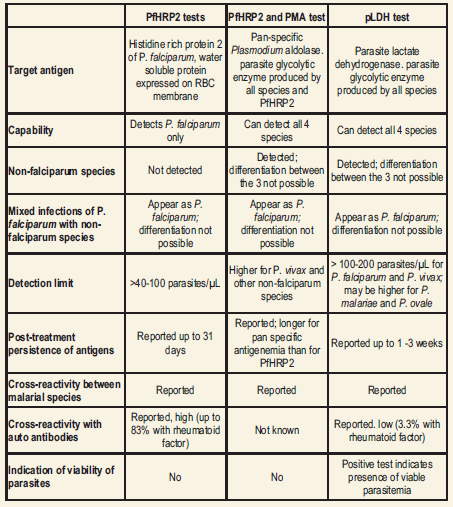

Microscopy is the more reliable method in rural areas where malaria is most prevalent.

The study, therefore, highlights the importance of both methods in diagnosis of malaria in endemic areas. Rapid diagnostic tests allow us to screen for malaria. Malaria rapid diagnostic tests (RDTs) are increasingly used as a tool for the diagnosis of malaria, both in endemic and in non-endemic settings. A comparison of microscopy with the RDTs, Paramax, Opitmal- IT, Omega, SD, showed a positive agreement index of 93%, 86%, 80% and 86%, respectively. The positive agreement index between RDT and microscopy was 89%. Of the 624 patients involved in the study, 197 (31.6%) tested positive and 427 (68.4%) tested negative to RDT whereas 190 (30.4%) tested positive and 434 (69.6%) tested negative to microscopy. Prevalence estimates from 22 surveys containing both microscopy and RDT results were compared using tests of agreement, and factors that could be influencing. G6PD rapid diagnostic tests For the treatment of Plasmodium vivax malaria, WHO recommends standard antimalarial medicines followed by a 14-day regimen of primaquine to prevent relapses of the disease.

Results from the rapid diagnostic kits were analyzed and compared to those obtained by general microscopy. The five different test methods were performed independently by well trained and competent laboratory staff to assess the presence of malaria parasites. Blood samples were collected randomly from 624 patients with clinical suspicion of malaria from four private hospitals in Georgetown, Guyana. Visual read-outs are available typically within 20 mins or less. These tests require a drop of peripheral blood, normally collected from a finger or heel prick. It provides rapid results and can be performed. Malaria rapid diagnostic tests (RDTs) assist in the diagnosis of malaria by detecting evidence of malaria parasites (antigens) in human blood. Population sample size: n= 607 from 100 selected random households to recruit children 6 months to 11 years old (Uganda), n=493 from visited households to recruit children and adults as part of an ongoing study to assess mass drug administration for malaria elimination (Myanmar), n=93 whole blood specimens from 16 human volunteers.The aim of this study was to compare rapid diagnostic tests (RDTs) for malaria with routine microscopy for a prompt and accurate diagnosis of malaria and to provide an effective disease management in Guyana. WHO has recommended the Blood-based Rapid Diagnostic Test (RDT) as an acceptable method for diagnosing malaria. Inclusion criteria: no fever history in the previous 7 days, axillary temperature less than 37.5☌, absence of other clinical signs of malaria, and no malaria treatment within the previous 60 days. The WHO recommends that all cases of suspected malaria should have parasitological test, supported by a quality assurance program to confirm the diagnosis of malaria. They rely on the detection of specific Plasmodium proteins, PfHRP2, pLDH and aldolase. RDT (RDT), the hsRDT uses the same immunochromatographic cassette platform, has the same whole blood volume requirements (5 µL), and takes only 5 minutes longer to result, making this device a promising and highly sensitive field tool.Ī quantitative reverse transcription PCR (qRT-PCR) and a highly sensitive enzyme-linked immunosorbent assay (ELISA) test for histidine-rich protein II (HRP2) were used as reference assays. Rapid diagnostic test for malaria The rapid diagnostic tests (RDTs) whose main interest lies in their implementation without special equipment by unskilled personnel have grown significantly over the past fifteen years to diagnose malaria. Compared with the current commercial HRP2-based SD BIOLINE Malaria Ag P.f. An Alere ™ Malaria Ag P.f Ultra Sensitive RDT (hsRDT) was developed for field use and evaluated for detection of low-density infections. Although laboratory assays are more sensitive than microscopy and RDTs, they are also more expensive, require highly trained personnel, take longer to produce results, and are more difficult to deploy for large-scale field use.


 0 kommentar(er)
0 kommentar(er)
